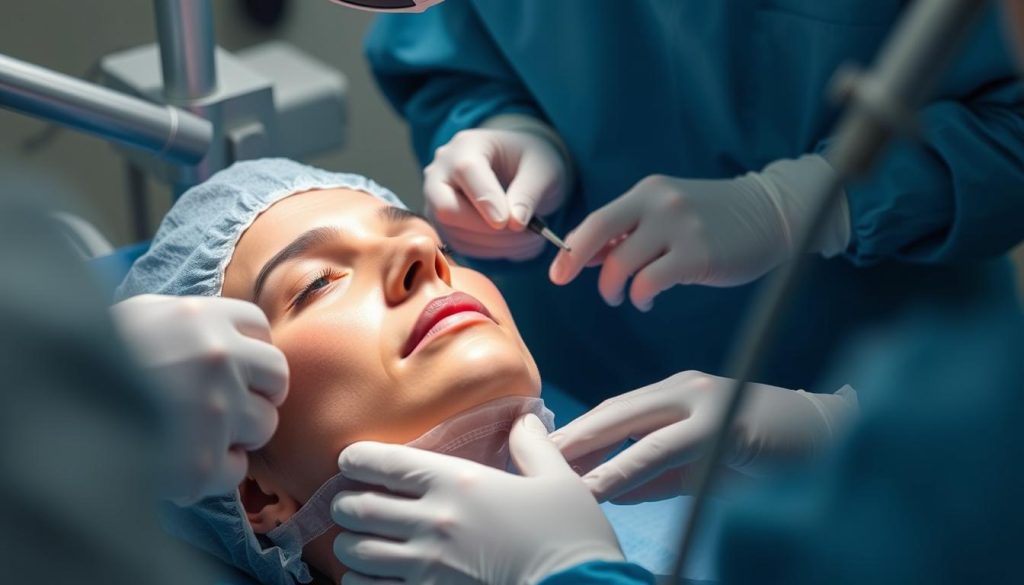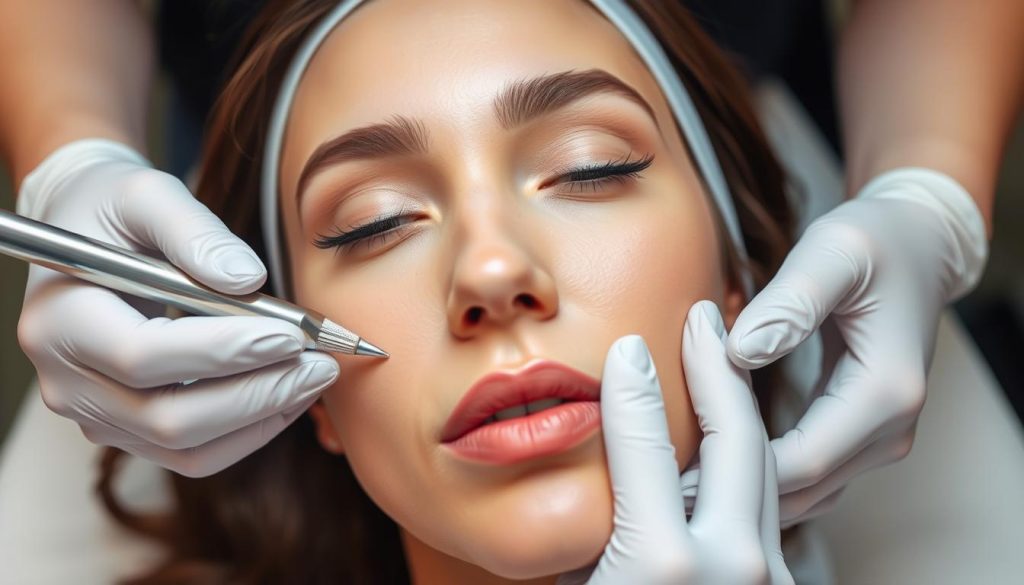Facial contouring has emerged as a specialized aesthetic procedure designed to enhance and balance facial features with precision. As people seek to refine their appearance, this technique has evolved to become one of the most sought-after cosmetic procedures.
The importance of a balanced face cannot be overstated, as it significantly impacts first impressions and can boost confidence and self-esteem. Contouring addresses both genetic facial structure issues and age-related changes, offering customized approaches based on individual needs.
Modern techniques focus on creating natural-looking results, and this article will explore various methods, benefits, and considerations to help readers make informed decisions about enhancing their face.
Key Takeaways
- Facial contouring enhances and balances facial features with precision.
- It addresses genetic facial structure issues and age-related changes.
- Customized approaches are available based on individual needs.
- Modern techniques focus on natural-looking results.
- Various methods and benefits will be explored to aid in informed decision-making.
Understanding Facial Contouring

Facial contouring is an art and science that aims to improve the proportion and harmony of facial features. Whether we like it or not, the face is typically what people notice most during first impressions.
The Science Behind Facial Harmony
The mathematical and artistic principles behind facial harmony involve the golden ratio and its application to facial proportions. Facial symmetry and balanced features are subconsciously associated with attractiveness across cultures.
Why Facial Balance Matters
Facial balance matters beyond aesthetics, as it has psychological benefits and can improve self-perception. Imbalanced facial features can create visual disharmony, which contouring techniques can correct. Facial contouring can be customized to enhance individual facial characteristics while maintaining a natural appearance.
By defining facial contouring as the art and science of reshaping facial features, individuals can achieve better proportion and harmony. This process addresses the relationship between different facial features, such as the nose, chin, cheeks, and jaw, to create a harmonious whole.
Benefits of Professional Facial Contouring
Professional facial contouring has revolutionized the way individuals enhance their facial features. This advanced technique offers numerous benefits, transforming not only one’s appearance but also their overall confidence.
Enhanced Facial Symmetry and Balance
Facial contouring creates enhanced facial symmetry by addressing structural imbalances and asymmetries. By correcting disproportionate features, it creates a more balanced and harmonious appearance. As stated by a renowned expert,
“Facial symmetry is a key determinant of attractiveness and perceived health.”
Boosted Self-Confidence
The psychological benefits of facial contouring include improved self-confidence and positive social interactions. Research highlights the connection between facial appearance satisfaction and overall psychological well-being.
Long-Lasting Results
Different facial contouring procedures offer varying durations of results. Surgical options generally provide longer-lasting results compared to non-surgical alternatives. Modern techniques ensure natural-looking results that age gracefully with the patient.
By providing customized results tailored to individual facial structures and aesthetic goals, professional facial contouring enhances not only the face but also one’s overall quality of life.
Surgical Facial Contouring Options

For individuals looking to redefine their facial structure, surgical facial contouring provides a variety of effective procedures. These surgical options offer permanent solutions for enhancing facial features and achieving a more balanced facial appearance.
Facial Implants
Facial implants are a popular surgical option for enhancing facial contours. They are made from various materials, including silicone and Gore-Tex, each with its own advantages.
Chin Implants
Chin implants are used to augment the chin, providing a more defined jawline and improving facial balance. This procedure is particularly popular among men seeking a more masculine appearance.
Cheek Implants
Cheek implants, including malar and submalar implants, are used to restore or enhance facial volume, creating more defined facial contours and addressing age-related volume loss.
Buccal Fat Removal
Buccal fat removal is a procedure that reduces fullness in the lower cheeks, creating a slimmer and more defined face shape. This surgery enhances cheekbone definition and can result in a more mature facial appearance.
Non-Surgical Facial Contouring Techniques

Non-surgical facial contouring has become increasingly popular due to its minimal downtime and immediate results. This approach offers a range of benefits for individuals seeking to enhance their facial features without undergoing surgery.
Dermal Fillers for Facial Sculpting
Dermal fillers are a popular non-surgical option for adding volume and structure to specific facial areas, creating more defined contours. Types of dermal fillers include hyaluronic acid and calcium hydroxylapatite, each with its own applications for facial sculpting.
Strategic placement of fillers can enhance cheekbones, define the jawline, and create better facial proportions. The use of dermal fillers allows for a tailored approach to facial contouring, addressing individual concerns and aesthetic goals.
Botox for Facial Contouring
Botox is commonly used for wrinkle reduction, but it also has applications in facial contouring, particularly for jaw slimming and facial reshaping. By relaxing specific muscles, Botox can create a more oval face shape and refined jawline.
The mechanism of Botox involves blocking nerve impulses in the muscles, which reduces fine lines and wrinkles while contributing to a slimmer facial appearance.
PDO Threads for Facial Lifting
PDO thread lifting is an advanced non-surgical technique that provides immediate lifting and stimulates collagen production. This method involves the use of absorbable threads made of PDO (Polydioxanone) to revitalize and restore facial contours.
The procedure is characterized by its painless and bloodless nature, allowing individuals to return to their daily activities immediately. PDO threads create both immediate and progressive improvements in facial contours, offering a versatile solution for facial rejuvenation.
Targeted Facial Contouring Procedures
Targeted facial contouring procedures offer a tailored approach to enhancing specific facial features, creating a more harmonious overall appearance. These procedures are designed to address individual facial attributes, providing a more balanced and aesthetically pleasing face.

Jawline Enhancement
Jawline enhancement is a popular procedure that can be achieved through both surgical and non-surgical means. Surgical options include jaw implants and jaw angle implants, which provide a more defined jawline. Non-surgical alternatives, such as dermal fillers and Botox, offer a less invasive approach to enhancing the jawline’s definition.
Cheekbone Definition
Cheekbone definition can be achieved through surgical cheek implants or non-surgical filler placement. Enhanced cheekbones create facial dimension, improve light reflection on the face, and contribute to a more youthful appearance.
Chin Augmentation
Chin augmentation is designed to enhance the shape and definition of the chin, improving facial profile and balance. This can be achieved through surgical chin implants or non-surgical methods like fillers and thread lifts. By enhancing the chin, individuals can achieve a more harmonious facial structure.
These targeted procedures can be combined to achieve comprehensive facial contouring results, offering a tailored approach to facial enhancement.
The Facial Contouring Process
The facial contouring process is a multi-step journey that begins with a comprehensive consultation. During this initial stage, Dr. Applebaum performs a thorough evaluation to understand the patient’s aesthetic goals and concerns.
Comprehensive Consultation
A comprehensive consultation involves a detailed facial analysis, discussion of aesthetic goals, and a review of the patient’s medical history. Advanced imaging technology and facial mapping may be used to assess facial structure and plan precise enhancements.
Customized Treatment Planning
Customized treatment planning involves developing a personalized approach based on the individual’s facial anatomy and desired outcomes. This may include combining different techniques for optimal results, such as dermal fillers, Botox, or PDO threads, to achieve the desired facial contour.
The Procedure Experience
The procedure experience varies depending on whether the facial contouring is surgical or non-surgical. Patients are prepared for the treatment, and anesthesia options are discussed to ensure comfort during the procedure. Following pre-procedure and post-procedure instructions is crucial for optimal results.
Recovery and Results
The success of facial contouring is not just about the procedure itself, but also about the recovery and aftercare. Facial contouring, whether surgical or non-surgical, is a journey that requires patience and understanding of the recovery process.
What to Expect During Recovery
Recovery from facial contouring varies depending on the type of procedure. For surgical facial contouring, the initial healing process typically takes a few weeks, during which swelling and bruising are common. For instance, procedures like facial implants and buccal fat removal may result in swelling that subsides over several weeks. In contrast, non-surgical treatments like dermal fillers and PDO threads have minimal downtime, with most patients resuming normal activities within a few days.
It’s essential to follow post-procedure instructions carefully to ensure optimal healing and results. This may include avoiding strenuous activities, keeping the treated area clean, and attending follow-up appointments.
| Procedure | Initial Healing | Swelling Reduction | Complete Tissue Adaptation |
|---|---|---|---|
| Surgical Facial Contouring | 2-4 weeks | 6-12 weeks | 6 months |
| Non-Surgical Treatments | 1-3 days | N/A | Varies |
Timeline for Visible Results
The timeline for visible results from facial contouring procedures can vary. For surgical procedures, it may take several months for the swelling to subside and the final results to become apparent. As stated by a renowned plastic surgeon, “It takes at least 6 months for the soft tissues to settle in to the size of the smaller bones.” Non-surgical treatments, on the other hand, may provide immediate results, with continued improvement as the treatments take full effect.
“Changes in the soft tissues surrounding the bones are just as important as changes in the bones.”
Understanding this timeline and being patient during the recovery process is crucial for achieving the desired outcome.

Choosing Between Surgical and Non-Surgical Options
Understanding the differences between surgical and non-surgical facial contouring options is crucial for making an informed decision. The choice between these two approaches depends on several factors, including the desired outcome, recovery time, and budget.
Factors to Consider
When deciding between surgical and non-surgical facial contouring, several factors come into play. The desired longevity of results is a key consideration. Surgical options like implants offer more permanent solutions, while non-surgical treatments such as fillers provide temporary results. Additionally, recovery time and budget are crucial factors that influence this decision.
Combining Techniques for Optimal Results
Combining surgical and non-surgical techniques can offer comprehensive facial enhancement. For instance, chin implants can be paired with jawline fillers to achieve a more defined facial structure. Similarly, cheek implants can be complemented with PDO threads for additional lifting. Consulting with experienced practitioners is essential to determine the most appropriate combination of treatments tailored to individual goals.
Transform Your Appearance with Expert Facial Contouring
Expert facial contouring can revolutionize one’s appearance, enhancing both physical features and self-confidence. By choosing a qualified plastic surgeon with specialized training in facial anatomy and contouring techniques, individuals can achieve natural-looking results that enhance their unique features.
A consultation with a specialist is crucial to determine the most appropriate facial contouring strategy for individual needs. This personalized approach ensures that treatments address both aesthetic concerns and age-related changes, providing comprehensive facial rejuvenation.
By investing in expert facial contouring, individuals can experience long-lasting improvements to their appearance and a significant boost in self-confidence. Schedule a consultation with Dr. Applebaum to explore your facial contouring options and take the first step towards transforming your face.
FAQ
What is the difference between surgical and non-surgical facial contouring?
Surgical facial contouring involves procedures like facial implants and buccal fat removal to alter the shape of the face, while non-surgical options use dermal fillers, Botox, and PDO threads to achieve similar results without surgery.
How long do the results of facial contouring last?
The duration of results varies depending on the procedure. Dermal fillers can last several months to a few years, while implants can provide permanent results. Botox effects typically last a few months.
What is the recovery time for facial contouring surgery?
Recovery time depends on the procedure. Some patients may experience swelling and bruising for a few weeks after surgery, while others may be back to normal activities within a few days.
Are facial contouring procedures painful?
Most procedures involve some discomfort, but anesthesia and pain management options are available to minimize discomfort. Non-surgical procedures may involve injections, which can cause temporary discomfort.
Can facial contouring be combined with other cosmetic procedures?
Yes, facial contouring can be combined with other procedures like lifting and skin rejuvenation treatments to achieve comprehensive results. A consultation with a qualified surgeon can help determine the best approach.
How do I choose the right surgeon for facial contouring?
Look for a board-certified surgeon with experience in facial contouring and a portfolio of successful cases. A thorough consultation can help assess their qualifications and determine if they’re a good fit.
What are the risks associated with facial contouring?
As with any surgical or non-surgical procedure, there are risks involved, including infection, scarring, and adverse reactions to materials used. A qualified surgeon will discuss potential risks and complications during the consultation.
